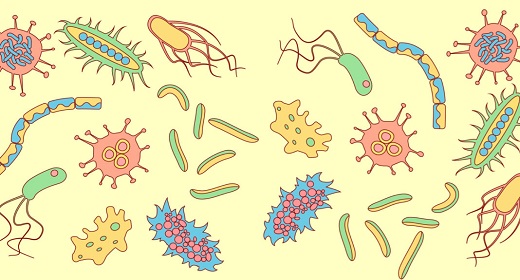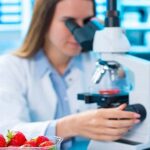by Naveen Jain: Hardly a day goes by without a research study or article published talking sh*t—or more precisely, talking about the gut microbiome…

When it comes to cutting-edge innovations in medicine, all signs point to the microbiome. Maybe we should have listened to Hippocrates: “All disease begins in the gut.”
Your microbiome is mostly located in your gut and contains trillions of little guys and gals called microbes. If you want to optimize your health, biohack your body, make progress against chronic disease, or know which foods are right for you—almost all of this information can be found in your microbiome.
My company, Viome, offers technology to measure your microscopic organisms and their behavior at a molecular level. Think of it as the Instagram of your inner world. A snapshot of what’s happening inside your body. New research about the microbiome is changing our understanding of who we are as humans and how the human body functions.
It turns out the microbiome may be mission control for your body and mind. Your healthy microbiome is part best friend, part power converter, part engine, and part pharmacist. At Viome, we’re working to analyze these microbial functions and recommend a list of personalized food and supplements to keep these internal complex machines in a finely tuned balance.
We now have more information than ever before about what your microbiome is doing, and it’s going to help you and the rest of the world do a whole lot better. The new insights emerging from microbiome research are changing our perception of what keeps us healthy and what makes us sick. This new understanding of the microbiome activities may put an end to conflicting food advice and make fad diets a thing of the past.
What are these new insights showing us? The information is nothing short of mind-blowing. The value of your poop just got an upgrade.
Here are some of the amazing things we’ve learned from our work at Viome.
1. Was Popeye wrong? Why “health food” isn’t necessarily healthy.
Each week there is a new fad diet released, discussed, and followed. The newest “research” shows that this is now the superfood to eat for everyone. But, too often, the fad diet is just a regurgitation of what worked for one person and shouldn’t be followed by everyone else.
For example, we’ve been told to eat our greens and that greens and nuts are “anti-inflammatory,” but this is actually not always true. Spinach, bran, rhubarb, beets, nuts, and nut butters all contain oxalate. We now know that oxalate-containing food can be harmful, unless you have the microbes present that can metabolize it into a non-harmful substance.
30% of Viome customers do not have the microbes to metabolize oxalates properly. In other words, “healthy foods” like spinach are actually not healthy for these people.
Looks like not everyone should follow Popeye’s food plan.
2. Aren’t foods containing “antioxidants” always good for everyone?
Just like oxalates, polyphenols in foods are usually considered very healthy, but unless you have microbes that utilize specific polyphenols, you may not get full benefit from them. One example is a substance found in these foods called ellagic acid. We can detect if your microbiome is metabolizing ellagic acid and converting it into urolithin A. It is only the urolithin A that has anti-inflammatory and antioxidant effects. Without the microbes to do this conversion you will not benefit from the ellagic acid in foods.
Examples: Walnuts, raspberries, pomegranate, blackberries, pecans, and cranberries all contain ellagic acid.
We have analyzed tens of thousands of people, and only about 50% of the people actually benefit from eating more foods containing ellagic acid.
3. You’re probably eating too much protein (and it may be causing inflammation).
When you think high-protein diet, you think paleo, keto, and high-performance diets.
Protein is considered good for you. It helps build muscle and provide energy—but if you eat too much, it can cause inflammation and decrease longevity.
We can analyze the activity of your microbiome to determine if you are eating too much protein that feeds protein-fermenting bacteria like Alistipes putredinis and Tannerella forsythia, and if these organisms are producing harmful substances such as ammonia, hydrogen sulfide, p-cresol, or putrescine. These substances can damage your gut lining and lead to things like leaky gut.
4. Something’s fishy. Are “healthy foods” causing heart disease?
Choline in certain foods can get converted by bacteria into a substance called trimethylamine (TMA) that is associated with heart disease when it gets absorbed into your body and converted to TMAO. However, TMA conversion doesn’t happen in individuals without these types of bacteria in their microbiome.
We can see the TMA production pathways and many of the gammaproteobacteria that do this conversion.
What foods contain choline? Liver, salmon, chickpeas, split peas, eggs, navy beans, peanuts, and many others.
Before you decide to go full-on pescatarian or paleo, you may want to check if your microbiome is producing TMA with that salmon or steak.
5. Hold up, Iron Man. We can see inflammation from too much iron.
Minerals like iron in your food can, in certain inflammatory microbial environments, promote growth of pathogens like Esherichia, Shigella, and Salmonella.
Maybe it wasn’t just that raw chicken that gave you food poisoning, but your toxic microbiome that made you sick.
On the other hand, when you don’t have enough iron, you could become anemic leading to weakness and shortness of breath.
So, just like Iron Man, it’s about finding your balance so that you can fly.
6. Are you anxious or stressed? Your poop will tell you.
Our gut and brain are connected via the vagus nerve. A large majority of neurotransmitters are either produced or consumed by our microbiome. In fact, some 90% of all serotonin (a feel-good neurotransmitter) is produced by your gut microbiome and not by your brain.
When you have a toxic microbiome that’s producing a large amount of toxins like hydrogen sulfide, the lining of your gut starts to deteriorate into what’s known as leaky gut. Think of leaky gut as your gut not having healthy borders or boundaries. And when this happens, all kinds of disease can emerge. When the barrier of the gut breaks down, it starts a chain reaction causing low-grade chronic inflammation—which has been identified as a potential source of depression and higher levels of anxiety, in addition to many other chronic diseases.
We’re not saying you shouldn’t meditate, but if you want to get the most out of your meditation and really reduce your stress levels, make sure you are eating the right food that promotes a healthy microbiome.
7. Your microbiome is better than Red Bull.
If you want more energy, get your microbiome back into balance.
No you don’t need three pots of coffee to keep you going, you just need a balanced microbiome.
Your microbiome is responsible for calorie extraction, or creating energy, through pathways such as the Tricarboxylic acid cycle. Our bodies depend on the energy that our microbiome produces.
How much energy we get from our food is dependent on how efficient our microbiome is at converting the food into energy. High-performing microbiomes are excellent at converting food into energy. This is great when you are an athlete and need the extra energy, but if you don’t use up the energy it may be the source of some of those unwanted pounds.
If the microbes can’t or won’t metabolize the glucose (sugar) that you eat, it will be stored as fat. If the microbes are extracting too many calories from your food or producing lipopolysaccharides (LPS) and causing metabolic endotoxemia leading to activation of toll-like receptors and insulin resistance you may end up storing what you eat as fat.
Think of your microbiome as Doc Brown’s car from the future—it can take pretty much anything and turn it into fuel if it’s strong and resilient enough.
8. We can see your joint pain in your poop.
Got joint pain? Your microbiome can tell you why.
Lipopolysaccharide (LPS) is a key pro-inflammatory molecule made by some of your microbes. If your microbes are making too much LPS, it can wreak havoc on your immune system by putting it into overdrive. When your immune system goes on the warpath there is often collateral damage to your joints and other body parts.
Perhaps balancing your microbiome is a better solution than reaching for the glucosamine. Think of your microbiome as the top general of your immune army. It puts your immune system through basic training and determines when it goes to war.
Ideally, your immune system wins the quick battle and gets some rest, but sometimes if your microbiome keeps it on constant high alert it becomes a long, drawn-out war resulting in chronic inflammation and chronic diseases.
Are you really “getting older” or is your microbiome just making you “feel” older because it keeps giving warnings to your immune system ultimately leading to chronic pain?
Before you throw in the towel on your favorite activities, check your microbiome. And, if you have anything with “itis” in it, it’s possible that when you balance your microbiome the inflammation from your “itis” will be reduced.
9. Your gut is doing the talking for your mouth.
When you have low stomach acid, your mouth bacteria makes it down to your GI tract.
Stomach acid is there to protect you from the bacteria in your mouth and the parasites and fungi that are in your food. If you don’t have enough of it, the bacteria in your mouth will invade your gut. This invasion is associated with and a risk factor for autoimmune disease and inflammation in the gut.
We are learning that low stomach acid is perhaps one of the major causes of chronic disease. This stomach acid is essential to kill mouth bacteria and help us digest our food.
What kinds of things cause low stomach acid? Stress and antacids like Nexium, Zantac, and Prilosec.
10. Carbs can be protein precursors.
Rejoice! Perhaps carbs aren’t as bad as we thought (as long as your microbiome is up to the task). We can see if some of the starches you eat can be made into amino acids by the microbiome.
Our microbiome makes 20% of our branched-chain amino acids (BCAAs) for us, and it will adapt to make these vital BCAAs for us in almost any way it can.
Essentially, your microbiome is hooking up carbons and hydrogens into different formulations of BCAAs, depending on what you feed it. The microbiome is excellent at adapting and pivoting based on the food you feed it and the environment that it’s in.
So, good news: Carbs are protein precursors, as long as you have the right microbiome.
Stop Talking Sh*t Now
Your microbiome is a world class entrepreneur that can take low-grade sources of food and turn them into valuable and useable energy.
You have a best friend and confidant within you that is working wonders to make sure you have energy and that all of your needs are met.
And, just like a best friend, if you take great care of your microbiome, it will take great care of you.
Given the research emerging daily about the microbiome and its importance on your quality of life, prioritizing the health of your microbiome is essential.
When you have a healthy microbiome, you’ll have a healthy life.
It’s now clear that some of the greatest insights for your health will come from your poop.
It’s time to stop talking sh*t and get your sh*t together. Your life may depend on it.
Viome can help you identify what your microbiome is actually doing. The combination of Viome’s metatranscriptomic technology and cutting-edge artificial intelligence is paving a brand new path forward for microbiome health.









































